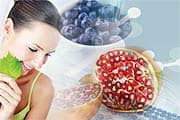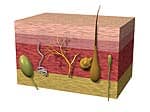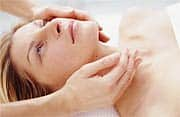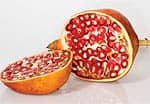Life Extension Magazine®
One of the most visible signs of premature aging occurs in the skin, where once firm, healthy collagen strands give way to wrinkling, dryness, and looseness. While external factors such as sun exposure can accelerate extrinsic skin aging, scientific evidence points to another culprit: glucose-driven intrinsic aging. Glucose is a vital cellular fuel. However, based on the accelerated rate of aging seen in diabetics,1 chronic glucose exposure has long been known to affect how the body ages by a process called glycation. Life Extension® members ingest nutrients like carnosine, pyridoxal-5-phosphate and benfotiamine to protect collagen against destructive glycation reactions. Fortunately, nature has also provided nutrients that when applied topically, can overcome skin glycation, leaving firmer, younger-looking skin. Here, we take a look at how these promising ingredients can strengthen collagen’s regenerative ability and help slow down intrinsic skin aging. How AGEs Are FormedThe same browning reaction that occurs when you cook meat at high heat takes place at a slower rate to long-lived tissue proteins such as collagen in our bodies.2 When the proteins in meat are exposed to heat and carbohydrates in the absence of moisture, they cause it to turn brown in a chemical process called the Maillard reaction. Similarly, in the human body, once sugars enter the circulation, they attach themselves to the amino groups of tissue proteins such as collagen to slowly rearrange their youthful structure into the main culprits of damage, called advanced glycation end products (AGEs). AGE molecules are particularly destructive since they can undergo extensive cross-linking with other proteins to form strong chemical bridges. As a result, once healthy collagen fibers lose their elasticity, becoming rigid, more brittle, and prone to breakage.3 Strong scientific evidence also indicates that glycation reactions are promoted by oxidative stress and lead to the production of reactive oxygen species in the skin.4 This assault on the skin’s structural support system contributes to the aging of tissues and, when accelerated by hyperglycemia, to the gradual development of diabetic complications. Not surprisingly, collagen abnormalities with aging and in diabetes share similar roots and have widespread consequences for the skin, such as thinning, discoloration, loss of elasticity, and tendency to rashes and infections. Skin Structure
Before we see how the skin is affected by glycation, let’s briefly review its structure. In order to provide a solid support to external influences, our skin consists of two layers: an outer layer called the epidermis and the layer below that called the dermis. New cells generated by the dermis are continually being pushed upwards to replace old cells, providing essential support to the epidermis. The dermis itself consists mainly of an extracellular matrix comprised of proteins, especially collagen fibers, elastin, and various glycoproteins, all of which are synthesized by major skin cells called fibroblasts. It also contains hyaluronic acid, which belongs to a class of large, sugar-like compounds known as glycosaminoglycans (GAGs). Hyaluronic acid is capable of holding up to 1,000 times its own weight in water and helps to bind water in the skin, providing essential support for the collagen framework as well as protecting the skin’s elasticity. There are several different types of collagen in the body. The major structural components in the skin are collagen types I and III, which account for over 70% and 15%, respectively of its dry weight and provide the dermis with tensile strength and stability.5 Another type of collagen—type IV—is responsible for the mechanical stability of the skin’s scaffolding, known as the basement membrane, which lies in the inner lining of the epidermis where it connects to the dermis. Glycation and Aging SkinHealthy collagen metabolism is a complex process that requires balanced synthesis and degradation to maintain the firm appearance of young, healthy skin. As skin ages, however, it becomes especially vulnerable to glycation, because collagen comprises up to one-third of the body’s proteins and has a slow turnover rate.6 Once glycated, collagen fibers have reduced regenerative ability, leading to the wrinkles, creping, and sagging that characterize skin aging.
A number of studies show that glycation of collagen increases with age2,7,8 when cells are exposed to not only high levels of glucose, but also to normal levels for a long enough time.2 A specific receptor for AGEs, called RAGE, has even been found to be expressed in skin fibroblasts that are responsible for synthesizing collagen,5 which further compromises skin integrity. Glycation not only impairs the assembly of collagen macromolecules,9 but it keeps type IV collagen molecules from forming a normal network-like structure.10 It also degrades collagen types I and III.11 After the age of 35, women naturally suffer a decline in collagen type IV, further exacerbating these changes.12 Laboratory research shows that once formed, AGEs can be self-perpetuating—directly inducing the cross-linking of collagen even in the absence of glucose.13 Glycation also induces fibroblast apoptosis (cell death),14 which creates a state of cellular senescence that has been shown to switch fibroblasts from a matrix-producing to a matrix-degrading state. In this state, the secretion of collagen-degrading enzymes, called matrix metalloproteinases (MMPs), increases and levels of their inhibitors decline.15 In fact, glycation directly increases the release of MMP-1, which preferentially breaks down collagen.16 While these assaults on the skin occur internally, external sources of oxidative stress can also aggravate skin aging. In particular, sun exposure increases levels of MMP-1 in the skin.17 Protein glycation and AGE formation are accompanied by increased free radical activity in skin collagen,18 which accelerates skin aging. All of these changes create an environment within the skin that favors degradation of collagen over its synthesis, compromising the integrity and regeneration of skin tissue. Powerful Nutrients That Fight GlycationWhile the effects of glycation may seem unrelenting and unavoidable, a number of topical nutrients have been scientifically shown to protect against the destructive effects of glycation and help boost the skin’s healing capacity. Blueberries: Enhancing Skin RenewalBlueberries possess supercharged antioxidant and anti-inflammatory powers and are packed with phytonutrients called anthocyanins that are responsible for their deep color. Scientific studies have revealed that anthocyanins such as those found in blueberries naturally avert glycation-induced damage by stabilizing the collagen matrix, promoting collagen biosynthesis, and improving microcirculation.19 The first evidence of the protective effect of blueberries came from studies in glaucoma and cataracts, which form part of the multitude of type 2 diabetic complications that are accelerated by glycation-induced damage to collagen structures in the eye. Researchers found that bilberry (blueberry’s close European cousin) extract halted the formation of cataracts in 48 of 50 patients19 and protected against glaucoma by strengthening collagen integrity in the eye.19 More recently, researchers have turned their attention to the skin-rejuvenating power of blueberries. What they have found is that blueberry extracts obtained from the stem, leaf, and fruit all exert a protective effect against protein glycation, AGE formation, and oxidative stress,20,21 with the blueberry stems exhibiting the greatest AGE-inhibitory activity.21
Researchers are also employing a relatively new way to evaluate a treatment’s anti-glycation effect in the skin. Using a reconstructed skin model, they can study biological changes in the skin when it is exposed to glucose. The use of AGE-inhibiting blueberry extract in this model has been found to return glucose-treated skin constructs to a more normal pattern of distribution, compared with an untreated model.3 In understanding blueberries’ remarkable effects on skin collagen, scientists have found that as well as strengthening collagen in human skin fibroblasts, anthocyanins in blueberries reduce the production of the collagen-breakdown enzymes called matrix metalloproteinases (MMPs).22 Specifically, they inhibit MMP-2 and MMP-9, which are major mediators of basement membrane degradation, an effect that has led investigators to conclude that blueberries may decrease overall extracellular matrix degradation.23
While reducing MMPs, blueberries also protect collagen by increasing the activity of tissue inhibitors of matrix metalloproteinases, in effect, activating endogenous systems to halt the breakdown of collagen.24 The anti-inflammatory properties of blueberries also have a valuable role to play in preventing direct damage to skin cells, which occurs when glycation directly activates inflammatory mediators and cytokines that break down collagen. Blueberry polyphenols overcome this damage by reducing TNF-alpha-induced up-regulation of various inflammatory mediators such as IL-8, MCP-1, and ICAM-1.25 What all of this means is that blueberries block detrimental sugar-protein reactions from occurring and work by multiple mechanisms to prevent the unwelcome formation of chemical bridges in collagen that cause its breakdown in the skin. In one study testing blueberries’ skin improving abilities, researchers tested the effects of an oral formulation that included blueberry extract, glycosaminoglycans, and micronutrients among its constituents, on skin aging in 62 women aged 45-73 years old. This placebo-controlled trial found that skin elasticity increased by 9% after just six weeks, while skin roughness was lowered by 6% after 12 weeks of treatment compared with the control group.26 The researchers concluded that the ingredients in this formulation “can potentially improve visible signs of cutaneous aging.” While these results are impressive, scientists have discovered even greater benefits when blueberry extract is applied directly to the skin. A controlled clinical study tested the efficacy of a topical preparation containing 4% blueberry extract as one of its constituents in 63 women aged 45-61 years. This study revealed that the topical mixture significantly improved cracking, creping, and thinning of mature skin when it was applied daily for three months. By the end of the study, 100% of test subjects showed a significant improvement in one or more of five distinct signs of intrinsic aging (Figure 1 on page 2). A dermatologist’s clinical evaluation also showed that by week 12, there was a 98% improvement in skin smoothness and a 30% improvement in wrinkles.27 Pomegranate: Powerful Antioxidant SupportWhile pomegranate has become increasingly renowned for providing a multitude of health benefits, it also possesses powerful antioxidant and anti-inflammatory properties that have been investigated for boosting the skin’s healing capacity. Rich in phenolic compounds such as ellagic acid, topically applied pomegranate promotes skin health in several ways. Pomegranate extracts increase dermal cell proliferation and collagen synthesis by providing nutritional support for fibroblast cells in the skin’s dermis as well as inhibiting MMP-1 production.28 Researchers have also shown that pomegranate helps reverse visible signs of aging by promoting a thickening of the skin’s outer layer—the epidermis.28 In addition to supporting the skin’s underlying structure, pomegranate helps protect the skin against the age-accelerating threats of ultraviolet light and inflammation,29 which can help result in younger-looking skin. | |||||||
Hyaluronic Acid: Essential Skin HydrationThe daily attack from protein-sugar glycation reactions does not stop at collagen, it also depletes the skin of its natural moisturizer called hyaluronic acid,30 which can cause dry and sagging skin. Replenishing the skin with hyaluronic acid counteracts the loss of skin volume and fullness that occurs with glycation and aging31,32 and increases cell renewal,33 helping to tighten loose areas of the skin. The controlled clinical study mentioned above that tested the efficacy of a topical mixture containing 4% blueberry extract also included another constituent that stimulates hyaluronic acid synthesis to restore the water and nutrient content in the skin. As mentioned previously, this mixture significantly improved five distinct signs of intrinsic aging in all 63 test subjects who applied it daily for 12 weeks (Figure 1 to the right).27 Vitamin C: Reviving Aging SkinVitamin C is an essential component in the body’s production of collagen34 and a potent antioxidant that can help rejuvenate aged and photodamaged skin.35 Although it is an important nutrient for overall health, little reaches the skin when vitamin C is orally ingested.36 As levels in the skin decline with age,37 replenishing vitamin C levels directly in the skin can help combat collagen degradation and oxidative stress. Results from clinical trials show that when applied topically, vitamin C promotes collagen formation,38 which helps improve skin firmness and elasticity, and mitigates the effects of age-promoting free radicals, which can help promote youthful-looking skin. Antioxidant Tea BenefitsThe benefits of any topical nutrient can be complemented with potent natural antioxidants found in white, green, black, and red tea extracts, which help protect skin from the aging effects of inflammation and oxidative stress.39,40 Red tea, in particular, is a powerful source of antioxidants,40 while green tea provides the protective strength of epigallocatechin gallate (EGCG) to guard skin against the dangers of UV exposure and DNA damage.41 Tea extracts are also excellent sources of vitamin C activity42 and improve both the tone and structure of the skin. SummaryGlycation accelerates the body’s intrinsic aging process by limiting the skin’s capacity to produce and regenerate high-quality collagen. While the best thing you can do is avoid sugars and refined carbohydrates, that is not always possible in the real world. To make things worse, the past few decades have seen an alarming increase in the dietary intake of sugar in the form of fructose from the ubiquitous high-fructose corn syrup—used as an additive in many processed foods such as soft drinks, breakfast cereals, and brand-name breads. Alarmingly, the rate of AGE formation on intracellular proteins occurs up to 10 times faster in the presence of fructose compared with glucose.43 It’s not just the sugar we eat but the way it is cooked that also harms our skin. Cooking and caramelizing food at high temperatures through methods such as barbecuing or broiling creates AGEs, which once consumed, bind to collagen and elastin fibers. Fortunately, a topical application of scientifically validated nutrients can help rejuvenate skin by protecting against the stiff sugar-protein bonds that accumulate as we get older. The superior anti-glycation benefits of blueberries coupled with the antioxidant power of pomegranates and tea extracts are complemented with hyaluronic acid and collagen-strengthening vitamin C to help protect and rebuild collagen, preserving the skin’s youthful appearance and helping maintain its structural and functional integrity. If you have any questions on the scientific content of this article, please call a Life Extension® Wellness Specialist at 1-800-226-2370. | ||||
| References | ||||
|








